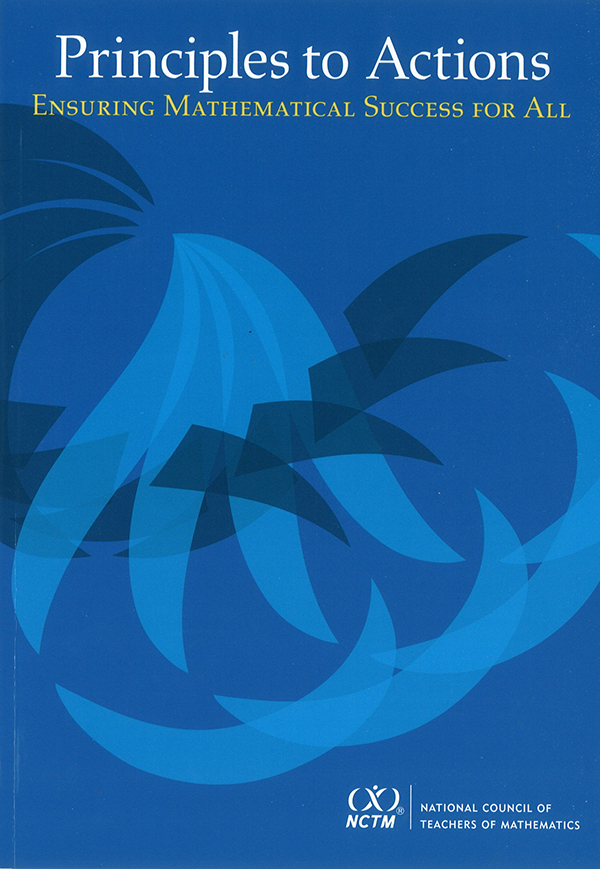
By The Mathematics Teacher Educator Editorial Board
The National Council of Teachers of Mathematics recently published Principles to Actions: Ensuring Mathematical Success for All. This document brings to the forefront issues of uneven implementation of the ambitious teaching (Lampert, Beasley, Ghousseini, Kazemi & Franke, 2010, p. 129) of mathematics to all students that has been espoused in various iterations of college and career ready standards, including the Common Core State Standards for Mathematics [CCSSM] (National Governors Association Center for Best Practices & Council of Chief State School Officers, 2010). The CCSSM provides guidance on what students should know and be able to do, but intentionally leaves unanswered questions about the policy and programs that should be in place in order to implement the content standards effectively. This resource is available at http://www.nctm.org/PrinciplestoActions.
The intent of Principles to Actions (PtA) is "to fill [the] gap between the development and adoption of CCSSM and other standards and the enactment of practices, policies, programs, and actions required for their widespread and successful implementation. Its overarching message is that effective teaching is the nonnegotiable core that ensures that all students learn mathematics at high levels" (p. 4). By specifying the kinds of practices that teachers need to engage in to support their students' learning of ambitious standards, and the kind of supports that need to be in place in order for teachers to implement these practices in their classrooms, the PtA is an important resource for mathematics teacher educators.
The PtA document is based upon research about effective mathematics teaching practices that are at the core of the work of mathematics teacher educators. This document makes explicit and accessible key components of effective mathematics teaching. As such, PtA coalesces many important ideas that AMTE members have been implementing in their work for decades (e.g., worthwhile tasks and purposeful questioning). It also draws attention to other key elements of effective teaching (e.g., productive struggle and using student thinking) that may not be as prevalent in our collective repertoire of strategies.
Specifically, PtA provides eight mathematics teaching practices that could serve as an organizational structure for professional learning communities or for designing goals and assessments for coursework or professional development. The document includes several helpful tables that summarize important ideas and could be used in the work we do as teacher educators. For example, the contents of a table of productive and unproductive beliefs about teaching and learning mathematics (p. 11) could be reformatted as a card sort and used as the basis of a conversation about values and classroom teaching or serve as the ends of a continuum for survey questions given at the beginning and end of a course or professional development experience. Other important conversations could be prompted by activities based on the vignettes and student work included in PtA. The possibilities for using PtA are numerous; regardless of what you decide to try, we encourage you to document your interventions in enough detail for your efforts to be replicable, and to share your results.
The Mathematics Teacher Educator (MTE) Editorial Board sees the publication of PtA as providing a stimulus for the AMTE community to develop a collection of (1) activities, (2) tools for gathering evidence, and (3) results in such a way as to provide opportunities for replication of effective practice in multiple contexts and for the refinement of our ideas—in other words, to contribute to the knowledge base of mathematics teacher education. These resources could serve as the basis of AMTE presentations and articles for AMTE publications. In particular, the MTE journal is putting out a call for manuscripts that document how mathematics teacher educators make connections between their work on improving practice (with preservice or inservice teachers) and the PtA document. Plan now to implement your ideas and be proactive and deliberate about the collection of evidence about their impact so that you will be ready to submit your manuscript by the September 1, 2015 deadline for this special call. More details are available on the MTE website: http://www.amte.net/publications/mte.
Editor's comment: Note that Nebraskan Matt Larson (Lincoln Public Schools) served as a member of the writing team.
References
Lampert, M., Beasley, H., Ghousseini, H., Kazemi, E., & Franke, M. L. (2010). Using designed instructional activities to enable novices to manage ambitious mathematics teaching. In M. K. Stein & L. Kucan (Eds.), Instructional explanations in the disciplines (pp. 129-141). New York: Springer.
National Council of Teachers of Mathematics. (2014). Principles to actions: Ensuring mathematical success for all. Reston, VA: Author.
National Governors Association Center for Best Practices & Council of Chief State School Officers. (2010). Common core state standards for mathematics. Washington, D.C.: Author.